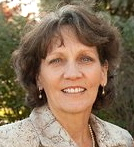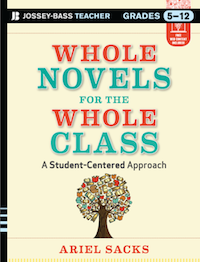Staying Student-Centered in Whole Novel Study
Whole Novels for the Whole Class: A Student-Centered Approach
By Ariel Sacks
(Wiley/Jossey-Bass Teacher, 2013 – Learn more)

It isn’t easy to swing open the door of a classroom and invite strangers in to watch, but that is exactly what middle school teacher Ariel Sacks has done with her book Whole Novels for the Whole Class.

She sees a shared reading experience as essential in building student skills in discussion, thinking, close reading, and writing. Sacks maintains this can be done along with the free choice reading we all want our students immersed in.
Sacks further argues that students need to experience a book in its entirety, the way real readers read, without ruining the flow of the story with piecemeal interruptions by well-intentioned teachers.
Students must read first, before delving into discussion and a review of the writer’s craft. And all students should read the same text to develop worthwhile eighth-grade level discussions and writings around a single text, making our curriculum accessible to everyone.
But how do we do it?
I can already hear the pushback. How can I possibly do that when I have English language learners, students reading well below grade level, and students well above? How can I expect my students to complete the reading? How can I let them read without leading the whole class from the front of the room every day—going too slowly for some, and far too fast for others?
Sacks anticipates and addresses these concerns. In her determination to bring together a cohesive community, she has worked her way through the practicalities. Every question a practicing teacher might have is addressed: how to support struggling readers, how to advance student thinking around text as they read, how to locate texts to meet the developmental needs of the age group, how to encourage good readers to go beyond without slowing their pace, and how to build an enthusiastic community of learners. Readers will feel confident enough to take on the challenge of presenting an authentic reading experience to everyone. I know I was.
In her determination to bring together a cohesive community, Sacks has worked her way through the practicalities.”
But there is even more to this rich guide. Sacks outlines how to build a meaningful year-long curriculum, introduces student friendly roles and titles, and makes specific recommendations for supporting all students. Her flexible program reaches across grades 5 to 12. (See the table of contents.)
From theory to practice – mundane to sublime
I found myself both studying and then sharing the pictures of Sack’s classroom. Though not nearly as deep as the theoretical discussion around presenting an entire novel to an entire class, I was amazed at my own relief when I could see the physical layout of the room. “But what does that look like?” is a question often unanswered in professional development experiences.
We often come on board with sound theory but are hamstrung by the daily practicalities of introducing new methods. Sacks provides answers for a myriad of issues from the mundane (where to store the texts and other materials) to the sublime (how to arrange a room to seamlessly move from small to large group work).
Additionally, she provides many examples of activities to engage students in thoughtful small group work, freeing her to work with a few students or with individuals. Plans are provided for a whole year, and a breakdown of schedules is shown around a whole novel.
I recently shared this title with teams of middle school English teachers, and they found all their questions addressed. This is the ultimate teacher-friendly manual for accommodating all students around a single text. The confidence of this master teacher is infectious.
Mary Tedrow is Director of the Shenandoah Valley Writing Project and a recently retired National Board Certified teacher at John Handley HS in Winchester VA, where she held the Porterfield Endowed English Chair and served as department chairperson. She is currently an adjunct at Shenandoah University and Lord Fairfax Community College and is the co-founder of Project Write, a non-profit corporation dedicated to developing young writers.


































